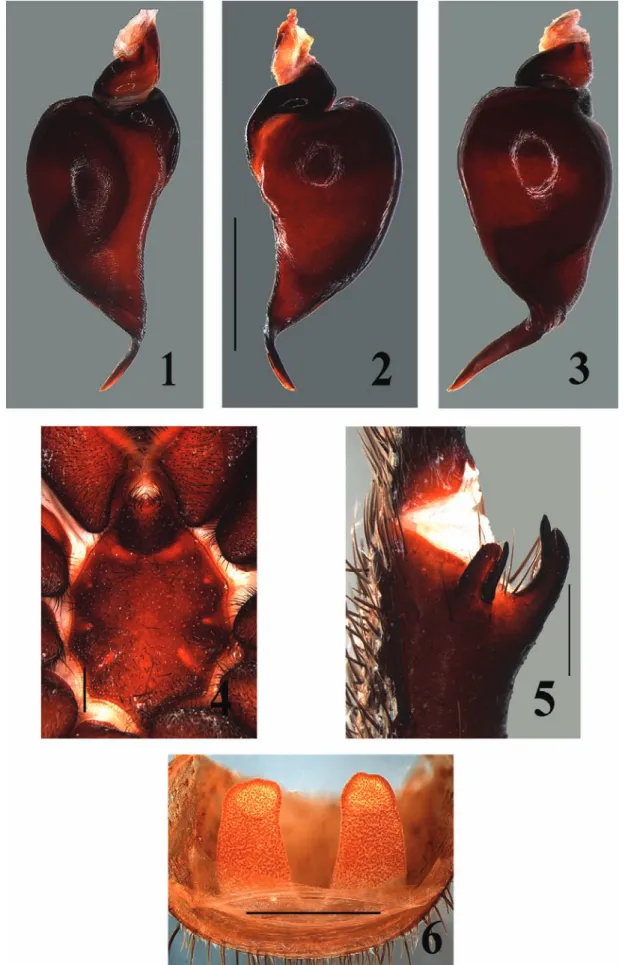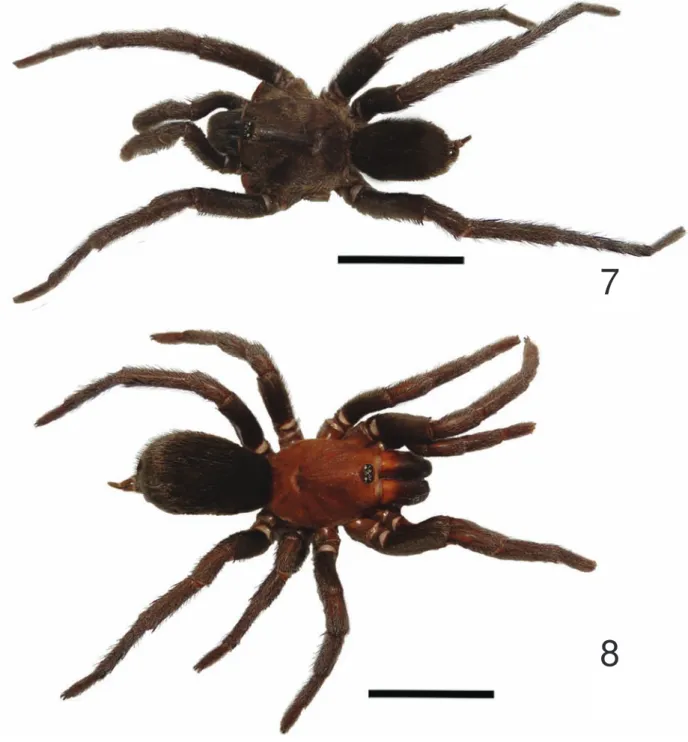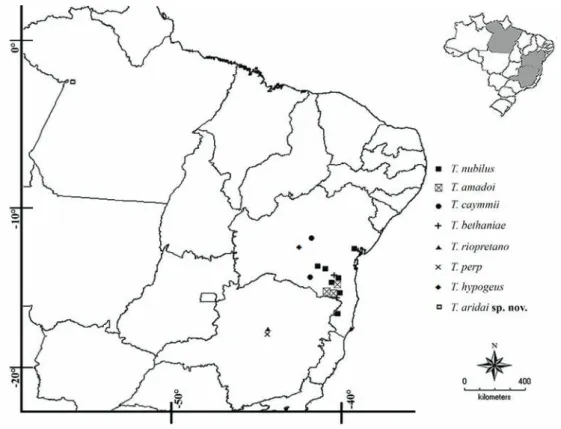DOI: 10.1590/1678-476620141042223227 Iheringia, Série Zoologia
A new species of
Tmesiphantes
(Araneae, Theraphosidae)
from the state of Pará, Brazil
Hector M. O. Gonzalez-Filho, Antonio D. Brescovit & Sylvia M. Lucas
Laboratório Especial de Coleções Zoológicas, Instituto Butantan, Av. Vital Brazil, 1500, 05503–900, São Paulo, SP, Brazil. (gonzalezfilho@yahoo.com.br;adbresc@terra.com.br;
sylviamlucas@gmail.com)
ABSTRACT. A new species of Tmesiphantes Simon, 1892, T. aridai sp. nov., is described and illustrated based on three males and three females
collected at the Floresta Nacional do Tapajós, Santarém, state of Pará, Brazil. Males can be distinguished from T. perp Guadanucci & Silva, 2012
by the palpal bulb with an inconspicous tegular basal projection, but presenting a very slender embolus with shorter keels not extending to the tip, and from T. nubilus Simon, 1892 by the tibial apophysis with two similarly sized branches, the prolateral one with a strong spine on the retrolateral
margin. Females resemble T. nubilus by the aspect of the seminal receptacle but the constriction near the apex is less evident and apex shape is
irregular. The new species represents the first record of Tmesiphantes from the Amazonian region, bringing the total number of species to eight.
KEYWORDS. Brazilian Amazon rainforest, Floresta Nacional do Tapajós, spider, taxonomy, Theraphosinae.
RESUMO. Uma nova espécie de Tmesiphantes (Araneae, Theraphosidae) do Estado do Pará, Brasil. Uma nova espécie de Tmesiphantes
Simon, 1892, T. aridai sp. nov., é descrita e ilustrada baseada em três machos e três fêmeas coletadas na Floresta Nacional do Tapajós, Santarém,
Estado do Pará, Brasil. Os machos distinguem se de T. perp Guadanucci & Silva, 2012 pelo aspecto do palpo copulador com uma projeção tegular
basal inconspícua, apresentando um êmbolo muito delgado, com quilhas mais curtas, não se estendendo até o ápice, e distinguem se de T. nubilus
Simon, 1892 pela apófise tibial com dois ramos de tamanho semelhante, o prolateral com um forte espinho na margem retrolateral. As fêmeas se assemelham a T. nubilus pelo aspecto dos receptáculos seminais, porém com uma constrição menos evidente e formato do ápice irregular. A nova
espécie representa o primeiro registro de Tmesiphantes para a região amazônica, elevando para oito o número de espécies conhecidas.
PALAVRAS-CHAVE. Região amazônica, Floresta Nacional do Tapajós, aranhas, taxonomia, Theraphosinae.
Tmesiphantes Simon, 1892 is a Neotropical genus of
Theraphosinae, based on a couple of specimens of T. nubilus
Simon, 1892 from the state of Bahia, Brazil, an Atlantic Forest domain. Males of Tmesiphantes can be recognized by
the palpal bulb morphology, with conspicuous superior and inferior prolateral keels and long curved embolus, aspect of the tibial apophysis and by the metatarsus I, which bends
to the retrolateral side of the retrolateral tibial apophysis,
females can be distinguished by the spermathecae with two seminal receptacles, slightly constricted near the apex
(Pérez-Mileset al.,1996; YaMaMotoet al.,2007), except in
T. hypogeus (see Bertaniet al.,2013, figs D, E). The genus was revised by YaMaMotoet al. (2007) with description of three new species: T. amadoi, known by a male, T. caymmii, known by male and female and T. bethaniae
known by a male, all from the state of Bahia. Guadanucci
& silva (2012) described the first two species registered
outside the Atlantic Forest domain, from the state of Minas
Gerais, Brazil: T. perp known by male and a female and T. riopretano based only on a male. Recently, Bertaniet
al. (2013) described T.hypogeus,based on two females
collected in the Gruna da Parede Vermelha and Gruna das Cobras, also from Bahia.
During the identification of the mygalomorph
spider’s collection of the Faculdades Integradas do Tapajós,
Santarém, Pará, Brazil, a new species of Tmesiphantes was
identified. This new species, T. aridai sp. nov., comprises
the first species recorded from the Brazilian Amazon
rainforest, which is here described and illustrated.
MATERIAL AND METHODS
The material examined is deposited in the following
institutions (abbreviation and curators in parentheses): Instituto Butantan, São Paulo (IBSP, A. D. Brescovit)
and Faculdades Integradas do Tapajós, Santarém (FIT, H. M. Chalkidis). All measurements are in millimetres and were taken with a millimetric ocular lens. Total body length excludes chelicerae and spinnerets. Length of leg segments were measured between joints in dorsal view, length and width of carapace, eye tubercle, labium and sternum are maximum values obtained. Abbreviations: AME, anterior median eyes; ALE, anterior lateral eyes; PME, posterior median eyes; PLE, posterior lateral eyes; spines: ap, apical; d, dorsal; p, prolateral; r, retrolateral; v, ventral. Terminology: palpal bulb structures follows Bertani
(2000), number and disposition of spines, Petrunkevitch (1925) and types of urticating hairs, cookeet al. (1972).
Pictures were taken with a Leica DFC500 digital camera attached to a Leica MZ16A stereoscopic microscope. The spermathecae were dissected and cleared in lactic acid
for internal structures observation and photographed in
dorsal view. The left male palpal bulb was removed from the cymbium and photographed in dorsal, prolateral and
retrolateral views. The left tibial spur was photographed
Figs 1-6. Tmesiphantesaridai sp. nov. 1-5, male holotype. 6, female paratype (IBSP 165019). 1-3, Left male palpal bulb: 1, prolateral view; 2, retrolateral
A new species of Tmesiphantes (Araneae, Theraphosidae)... 225
Figs 7-8. Tmesiphantesaridai sp. nov., habitus, dorsal view: 7, male holotype; 8, female paratype (IBSP165019). Scale bars: 1 cm. Photos: Rafael
P. Indicatti.
clearer view. The geographic coordinates were obtained
using the program Google Earth and the distribution map was made using the program DIVA- GIS 7.5.
RESULTS
Tmesiphantesaridaisp. nov. (Figs 1-9)
Type material. Holotype ♂ from Floresta Nacional do Tapajós (55°30’-54°36’W, 02°30’- 4°18’S), Santarém, Pará, Brazil, X. 2011, A. D. Brescovit et al. leg. (IBSP
161737). Paratypes: 3♂ (IBSP 161736, IBSP 165996, FIT
1036) and 3♀ (IBSP 165019, IBSP 165020, FIT 1129),
same data of holotype.
Etymology. The specific name is in honour of Felipe
Arida, grandson of the last author.
Diagnosis. Males of Tmesiphantes aridai sp. nov.
resemble T. perp (seeGuadanucci & silva, 2012, figs 11-13)and T. nubilus (see YaMaMotoet al.,2007, figs 3-5) by
the morphology of the palpal bulb, but can be distinguished from T. perp by the palpal bulb with an inconspicuous tegular basal projection, but presenting a very slender
embolus with shorter keels not extending to the tip (Figs
7
Fig. 9. Distribution map of the species of Tmesiphantes.
1-3), and from T. nubilus (see YaMaMotoet al.,2007, fig.
6) by the tibial apophysis with two similarly sized branches,
the prolateral one with a strong spine on the retrolateral
margin (Fig. 5). The females of the new species resemble
T. nubilus due to the aspect of the seminal receptacles,
but the constriction near the apex is less evident and apex
shape is irregular (Fig. 6).
Description. Male (Holotype, IBSP 161737).
Carapace, legs and abdomen dorsally dark brown (Fig. 7). Sternum, coxae and abdomen ventrally reddish brown
(Fig. 4). Total length 22.5. Carapace 11.13 long, 9.13 wide, fovea procurved (Fig. 7). Clypeus narrow. Eye tubercle: 1.0 long, 1.63 wide. Eyes size and inter-distances: AME 0.33, ALE 0.45, PME 0.2, PLE 0.35, AME-AME 0.16, AME-ALE 0.1, PME-PME 0.7, PME-PLE 0.08,
ALE-PLE 0.1. Labium: 1.4 long, 1.7 wide, with 10 cuspules. Sternum: 4.55 long, 4.2 wide, oval (Fig. 4). Endites with 72/67 cuspules (right/left). Basal segment of chelicerae with 14 teeth on prolateral margin. Palp: femur 5.63/ patella 3.5/tibia 4.88/cymbium 3.75/total 17.75. Legs: I: femur 8.66/patella 3.88/tibia 6.88/metatarsus 6.63/ tarsus 4.0/total 30.0; II: 8.13/4.5/5.88/6.38/4.13/29.0; I I I : 7 . 5 / 3 . 6 6 / 5 . 1 3 / 7 . 5 / 3 . 8 8 / 2 7 . 6 3 ; I V:
9.75/3.66/8.0/10.5/4.66/36.5. Spination: all tarsi without
spines; palp: femur p0-0-1, patella p0-1, tibia p0-1-2ap; legs: I: femur p0-0-1-1ap, tibia v1r-0-1r-1-1r-1p-1ap, metatarsus v0-2-0-0-1-2-0-1-1ap; II: femur p0-0-1, patella p0-1, tibia v0-2-0-0-1-1-0-0-3ap, p0-0-1-1-0-1, metatarsus v2-0-0-1-0-0-3ap; III: femur d0-0-1r, patella d0-1, tibia v0-1-1p-0-1-0-1r-0-3ap, metatarsus r0-2-0-1-0-1, v0-1p-0-2-0-0-1d-3ap; IV: femur d0-0-1r, tibia
v0-1-3-0-0-1r-2-1-0-1p-0-0-1r-0-3ap, metatarsus d0-2-0-0-0-1-0-1,
v2-0-0-0-1-0-1-0-1-0-1r-4ap. Tarsal scopulae: I undivided, II–IV divided by a longitudinal band with around 40 setae. Metatarsal scopulae: I-II on apical third, III restricted to
apical fifth, IV with few apical setae. Metatarsus I slightly
curved. Urticating hairs type III present. Palpal bulb with
a slight curvature to the embolus, inconspicuous tegular basal projection, superior and inferior keels thin (Figs 1-3). Tibial apophysis with two strong branches of similar size,
the retrolateral one large with an apical spine, the prolateral
one with a spine situated basally on the retrolateral margin
(Fig. 5).
Female (Paratype, IBSP 165019). Carapace yellowish-brown, legs and abdomen dorsally dark brown (Fig. 8). Sternum, coxae and abdomen ventrally as in male.
Total length 20.63. Carapace 7.2 long, 6.9 wide, fovea procurved (Fig. 8). Clypeus narrow. Eye tubercle: 0.6 long, 1.38 wide. Eyes size and inter-distances: AME 0.43, ALE 0.48, PME 0.20, PLE 0.28, AME 0.16, AME-ALE 0.1, PME-PME 0.7, PME-PLE 0.08, AME-ALE-PLE 0.1.
Labium: 1.13 long, 1.73 wide, with 8 cuspules. Sternum: 3.97 long, 3.84 wide, as in male (Fig. 4). Endites with 62/67 cuspules (right/left). Basal segment of chelicerae with 11 teeth on prolateral margin. Palp: femur 4.05/patella 2.8/tibia 3/cymbium 2.65/total 12.5. Legs: I: femur 5.3/ patella 3.4/tibia 4.6/metatarsus 3/tarsus 2.15/total 18.45; II: 4.6/3.2/3.65/2.9/2.25/16.6; III: 5.1/3.05/2.25/3.35/1.75/15.5;
IV: 5.6/3.65/5.25/6.25/3.1/23.85. Spination: all tarsi without
A new species of Tmesiphantes (Araneae, Theraphosidae)... 227
p0-1, tibia v0-1-0, p0-1-1-1-0-2ap, r0-1-0-1, metatarsus v0-0-3-1p-0-4ap; IV: femur d0-0-1, patella p0-1, tibia v0-0-1r -1p-0-2ap, metatarsus
v1r-0-1r-2-0-1-1-0-1p-0-1d-4ap. Tarsal scopulae: I–IV divided by a longitudinal
band of setae as in male. Metatarsal scopulae: I-II 1/3 apical, III restricted to apical fifth, IV with few apical setae. Urticating hairs type IV present. Spermathecae formed by two receptacula with little constriction near apex (Fig. 6).
Variation. Males (n = 4): total length: 18.37-22.5.
Labium with 7-13 cuspules. Female (n = 3): total length: 17.13-20.63. Labium with 6-13 cuspules.
Distribution. Known only from the type locality
(Fig. 9).
Acknowledgements. We wish to thank Dr. Hipócrates Chalkidis
for the donation of the specimens, to Rafael P. Indicatti for assistance in illustrations, also to Ray Gabriel for helpful comments and corrections on this manuscript. This work was supported by FAPESP (2011/50689-0), INCTTox PROGRAM of CNPq (Conselho Nacional de Desenvolvimento Científico e Tecnológico) to ADB and PAP program to HGF.
REFERENCES
Bertani, R. 2000. Male palpal bulbs and homologous features in
Theraphosinae (Araneae, Theraphosidae). Journal of Arachnology 28:29-42.
Bertani, r.; Bichuette, M. e. & Pedroso, d. r. 2013. Tmesiphantes hypogeus sp. nov. (Araneae, Theraphosidae), the first troglobitic
tarantula from Brazil. Anais da Academia Brasileira de Ciências 85:235-243.
cooke, J. a. l.; roth, v. d. & Miller, F. r. 1972. The urticating hairs of theraphosid spiders. American Museum Novitates 2498:1-43. Guadanucci, J. P. l & silva, W. F. 2012. Two new species of Tmesiphantes
Simon (Araneae, Mygalomorphae, Theraphosidae) from the state
of Minas Gerais, Brazil. Studies on Neotropical Fauna and Environment 47:139-145.
Pérez-Miles, F.; lucas, s. M.; silva Jr, P. i. & Bertani, r. 1996.
Systematic revision and cladistic analysis of Theraphosidae (Araneae,
Theraphosidae). Mygalomorph 1:33-68.
Petrunkevitch, a. 1925. Arachnida from Panama. Transactions of the
Connecticut Academy of Arts and Sciences 27:51-248. YaMaMoto, F. u.; lucas, s. l.; Guadanucci, J. P. l & indicatti, r.
P. 2007. Revision of the genus Tmesiphantes Simon (Araneae,
Mygalomorphae, Theraphosidae). Revista Brasileira de Zoologia 24:971-980.


